Can Pizza Be Healthy and also Delicious? Must-Try Plant Based Pizzas
Pizza is one of the most popular foods on the planet. It’s known for being gooey, savory, tasty, and a great party and finger food. Only problem is, most pizzas also deliver a heavy dose of salt, empty calories, and saturated fat. Can the pizza be saved so that health-conscious, plant-based eaters still get to enjoy it? Let’s give it a try!
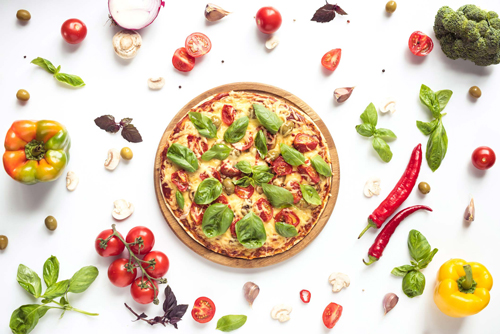
People have been baking flatbreads and adding toppings to them for millennia. And pizza precursors span the globe. We know that Persian soldiers actually baked flatbreads topped with cheese and dates on their shields. Hopefully, they had time to clean them off before the next battle! And Greek hero Aeneas tells the story of Trojan soldiers eating round breads topped with vegetables.
The pizza as we know it and love it today seems to have originated in Naples, Italy. They had to wait for European exploration of the New World for the key ingredient, tomatoes, which are native to the Americas and weren’t grown in Europe until one of the first explorers brought back some seeds. These strange-colored eggplants, as they were first described, were found to be delicious when seasoned with salt, pepper, and oil. Soon they were dubbed “golden apples,” or pomi d’oro.
Modern Pizza’s Development
One of the simplest and most iconic variations is Pizza Margherita, allegedly invented in 1889 in honor of a visit to Naples by Queen Margherita. The inspiration was visual – a dish sporting the three colors of the Italian flag: red (tomato), green (basil), and white (mozzarella cheese.)
Italian immigrants to the US brought the dish with them in the 19th century, although its popularity was initially limited to immigrant communities. The first pizza restaurant in the country, Lombardi’s in New York City, opened in 1905. But when tens of thousands of servicemen and women returned from Italian campaigns after World War II, they also brought with them an appreciation of Italian cuisine that included a strong hankering for pizza.
In the 1950s and beyond, the market for pizza exploded to the point where today a pizzeria is a staple in just about every community in the US. And giant restaurant chains specializing in pizza compete for market share on billboards and in commercials.
By 2019, the global pizza market had annual sales estimated of nearly $145 billion. That’s a lot of dough tossing! Americans and Western Europeans eat the most, per capita. But you can find pizza just about everywhere you can find electricity and running water. And different countries and regions have added their unique ingredients, flavor profiles, and sensibilities to the ever-evolving pizza.
The Problem with Pizza
From thin crusts and small amounts of cheese that dotted the classic Italian “tomato pie,” pizza has evolved into a supersized transport vehicle for sodium and saturated fat.
The Cheese
Modern commercial such “tomato pies” can have up to a pound of cheese on them, a statistic caused in part by the US government’s subsidies to the dairy industry. It turns out, the US government has lobbied and paid corporations like Pizza Hut and Dominos to add as much cheese as possible to their “pies” as a way of shrinking the gargantuan US cheese surplus. There’s so much extra cheese, they’re even sticking it in the crust!
Lots of vegans have had the experience of ordering a pizza without cheese, and then getting a “pie” covered in cheese anyway. A common explanation: “Oh, I thought you meant no extra cheese.” Even though a cheeseless pizza covered in tomato sauce and veggies is totally delicious, it’s almost impossible for most people (and especially, it would seem, employees at pizza joints) to conceive of such a “pie”.
The Meat
A second source of saturated fat and chronic disease from pizza is processed meat. Pepperoni and sausage sourced from factory farms are among the most popular pizza toppings. And it’s not uncommon to also find chicken, meatballs, ham, bacon, and anchovies. Processed meats like these can increase your risk of heart failure, especially the red meats. Red meat has triple the levels of TMAO or trimethylamine N-oxide, a byproduct of red meat consumption formed by gut bacteria during digestion and linked to heart disease. Not to mention, eating meat is thoroughly harming your body, and even consciousness, in countless ways.

The Crust
And then there’s the crust. Most pizza crusts are made from white, all-purpose wheat flour, which is almost always contaminated with the herbicide glyphosate. With the exception of a few high end and health conscious pizzerias, it’s hard to find 100% whole wheat or even a combination of whole wheat and white flour, let alone organic. More and more establishments are offering gluten-free crusts. But these are typically no healthier than refined wheat flour, and often less so. They can feature white rice, tapioca flour, potato starch, and lots of fillers and binders that were created in a lab rather than grown in a field.
The Sodium
Pizza is also one of America’s leading sources of sodium, as salt is typically added to the cheese (to disguise its low quality), the dough, the tomato sauce, and the toppings. Just glance at the nutrition facts label on a conventional frozen pizza box to see how many days’ worth of sodium is hiding in that large “pie”. The USDA estimates that a typical “parlor pie” contains about 5,100 mg of sodium — about three times the daily limit recommended by the American Heart Association. And typical pizzas also contain a fair share of sugar, flavorings, preservatives like BHA/BHT and MSG, nitrites and nitrates, and lots and lots of oil. And many of these ingredients are full of GMOs as well.
Are Healthy Plant-Based Pizzas Possible?
Have we reached the sad end of our epic tale of pizza? From a clever way to eat toppings with our hands without needing a napkin to a modern-day driver of heart disease and an ever-expanding waistline? Have no fear. With some creativity, we can return pizza to its convenient, delicious, simple, and health-promoting roots. And with the revolution in plant-based dairy and meat analogues, we can also create yummy plant-based pizzas that can satisfy even the committed meat and cheese eaters.
A Healthier Crust
Let’s start with the crust. Simply replacing the white flour with whole grains, ideally organic and GMO-free, will go a long way toward healthifying a pizza. Also, once you get used to whole grain bread, you’ll discover that it tastes a lot better than the “wonder bread” type crusts you can get at commercial pizzerias. But wait, there’s more!
You can make delicious crusts for your plant-based pizzas with nut flours, such as almond — and even riced cauliflower. If you’re in a hurry and don’t have time to make the dough yourself, you can always substitute a whole-grain bread or a whole-grain or sprouted tortilla. Cornmeal crusts, naturally gluten-free (make sure it’s organic to avoid GMO corn), are also commercially available and easy to make at home.
Sauce from Scratch
The classic pizza is topped with some kind of tomato sauce, which can be a health food all by itself. Cooked tomatoes are in many ways more nutritious than raw ones, and are a rich source of vitamin C and lycopene. As long as you go easy on the sugar, oil, and salt, you can make a delicious plant-based sauce that anyone’s grandma would be proud of.
If you want to make sauce from scratch, and you’re pressed for time, here’s a trick: pour a jar or a BPA-free can of plain tomato sauce (only ingredient: tomatoes) and a can of diced tomatoes into a saucepan. Add garlic powder, onion powder, Italian herb mix, ground black pepper, and a tiny bit of maple syrup to balance the acidity of the tomatoes (optional if you’re avoiding sweets), and heat for about 10 minutes. You’ll get a much cleaner and healthier sauce than most supermarket brands. And also one that’s plenty tasty and a whole lot less expensive. Triple win!
Of course, you don’t have to limit yourself to the traditional tomato sauce. You can substitute BBQ sauce (homemade is best to avoid all the sugar found in commercial brands), a plant-based pesto, or even a bean spread like hummus.
Elevated Toppings
Most of us, when we think of pizza toppings, take the cheese for granted (just like the folks who make “cheeseless pies” with cheese for disappointed vegans). So let’s deal with the elephant on the pizza before moving on to other toppings.

Cheese
You can, of course, go totally cheeseless. There’s absolutely nothing missing on a “pie” with a quality crust, delicious sauce, and savory vegetables like mushrooms, onions, peppers, tomatoes, garlic, pineapple, artichoke hearts, and spinach. As long as the baker understands how not to dry out or burn the veggie-based toppings in the absence of cheese, you’ll get a perfectly delicious pizza without the side order of heart disease.
The world of plant-based dairy can come to the rescue if you do want to retain the cheesy nature of pizza. There are many brands that make vegan cheeses that taste and even melt like the dairy kind. If you’re concerned about health, check the ingredients. Some are way more processed and have a lot more saturated fat than others. And as with any processed food, use them sparingly rather than as a two-inch covering.
You can also make your own “cheese” from plant-based ingredients like nuts, seeds, beans, nutritional yeast, sweet potatoes, carrots, winter squash, etc. Here’s a comprehensive article on homemade nut cheeses.
All the Veggies!
Your imagination is the only limiting factor when it comes to adding veggies to plant based pizzas. Beyond the well-known vegetable pizza topping why not try adding summer or winter squash, carrots, kale, or sweet potato? You can keep the toppings thin, or stack them up in defiance of gravity.
Fruit
Yes, fruit can go on pizza! Technically, tomatoes and peppers are also fruit, so it’s not as big a leap as you might think. And since most commercial tomato sauce is full of sugar, why not get the sweetness on your pizza from fruit, the original source of sugar?
Pineapple is the most common fruity pizza topping, often on the classic Hawaiian-style pie. (Fear not, we’ve got a recipe for you below that gives you the best of the Hawaiian without the meat or cheese.) You can also try adding figs, pears, or even sliced apples.
Herbs/Spices
You can go with classic Italian herbs, like oregano, basil, marjoram, and thyme. Or you can mix it up with flavor profiles from lots of other cuisines: Mexican, Thai, Mediterranean, West African, and so on. Lots of stores sell pre-mixed spice blends, so you can get started without investing in a bunch of different spices. If you’re going low-sodium, just be sure to opt for blends without added salt.
Meat Analogues
More and more companies make increasingly convincing plant-based meat analogues, including traditional pizza “veggie pepperoni” and “soy sausage”. Use these sparingly, as they’re usually full of processed ingredients and still relatively high in sodium. It’s funny how, to people who normally love or miss meat, even just a few thin slices of vegan sausage on an entire pizza can improve the impression from one of lack to one of abundance.
Alternately, you can approximate the umami flavor and texture of meat with more natural ingredients, such as grilled mushrooms or crumbled tempeh. One of the recipes below features barbecued tofu in place of ham.
Recipes for Delicious Plant-Based Pizzas
Tofu Mushroom Pineapple Pizza with Mozzarella Cashew Cheese

The smoky vegetables and tofu combined with sweet pineapple then topped with creamy mozzarella cashew cheese makes for an out-of-this-world combination. Make the mozzarella cheese, press the tofu, and precut the vegetables and pineapple ahead of time to save some prep minutes.
Turmeric Cashew Cheese Cauliflower Crust Pizza
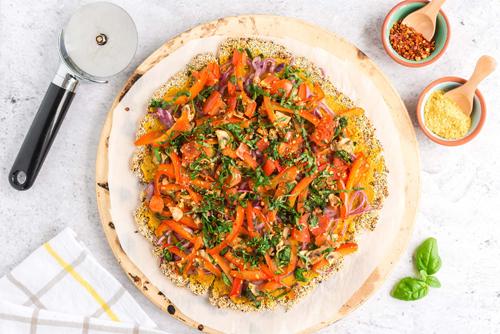
This pizza is simple to create if you make the turmeric cashew cheese first and use store-bought cauliflower crust (however, we do recommend making your own if you have the time!). The cheese recipe will make more than double the amount you need for the pizza, allowing you to make it on one day and use it throughout the week on wraps, in salads, and, of course, reserving some for the pizza. With the cauliflower crust and fresh vegetables, this is a light, refreshing, and nourishing dish for the spring and summer evenings!
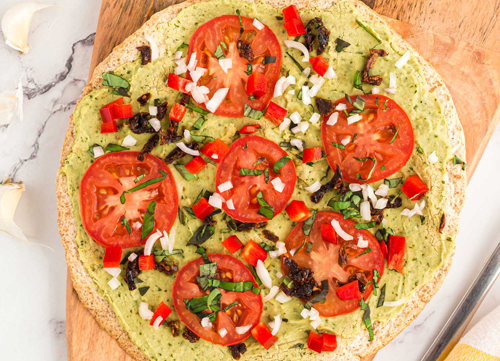
Have you thought about experimenting with white cannellini beans as a cheese replacement? Now’s your chance! Blend the fiber and protein-packed beans with lemon and herbs to create a delicious and healthy alternative to cheese. Not to mention, the options for vegetable toppings on this pizza are endless!
Thai Red Pepper and Carrot Pizza with Cashew Mozzarella Cheese
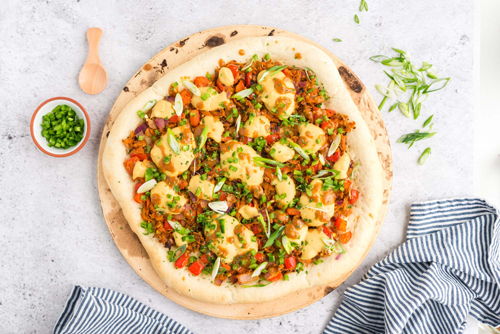
Peanutty (substitues available!) vegetables topped with cashew mozzarella? Yes, please! The sweet and tangy peanut sauce combined with the savory and creamy cashew cheese is sure to satisfy all your tastebuds. If you’re a spice fan, top it with jalapeno for an all-around flavorful and energizing pizza!
Best Grain-Free Vegan Pizza with Caramelized Onions and Mushrooms
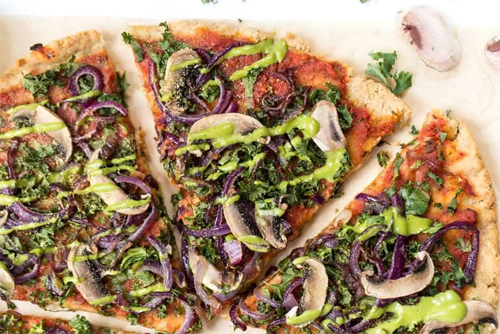
This pizza dough is made with almonds, so you can make it whenever you invite vegans and Paleo eaters to the same party. The caramelized red onions and mushrooms provide umami goodness. And the chopped kale turns it into a true nutritional powerhouse.
Spinach-Cashew Pizza Cheese Spread
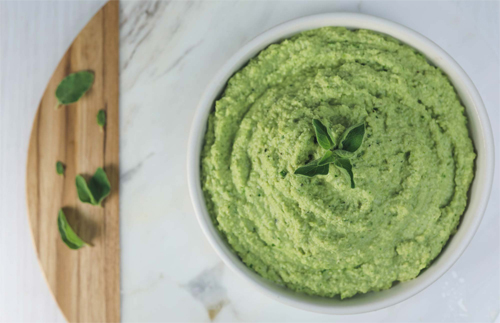
This spread is similar to pesto, but with a little more punch so it can hold its own on a pizza crust along with bold toppings. However, it’s versatile enough for adaption as a pesto or to use as a dip or spread for other snacks and meals. Some people like an extra dollop alongside their serving of pizza! Spread on a crust, throw on some toppings of your choosing, stick it in the oven (following your typical pizza cooking instructions), and voila, you have a delicious, cheese-free pizza! For oil-free cooking, use water in place of oil. If you’re watching sodium, omit the salt or decrease by half.
yogaesoteric
October 3, 2020
Also available in:
 Français
Français
